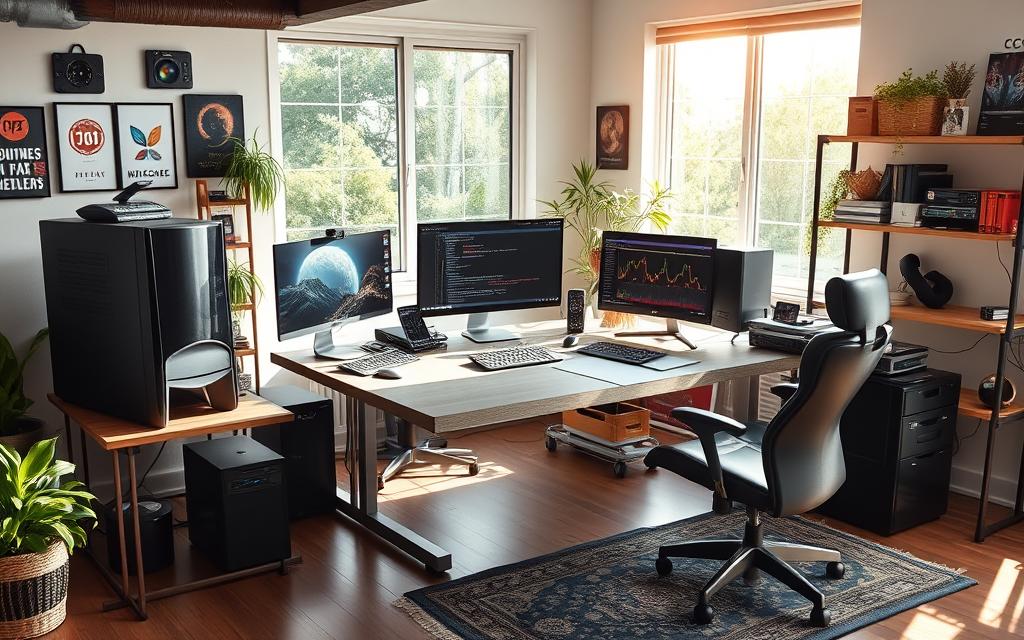Table of Contents
The global custom computer market is booming, valued at over $45 billion. This growth offers exciting opportunities for entrepreneurs with a passion for technology. Whether you’re targeting gamers, remote workers, or professionals, the demand for specialized systems is on the rise.
Success in this field requires a blend of technical expertise and business acumen. Companies like Vision Computers and Total Data Solutions have carved out niches by focusing on quality and customer needs. Their stories highlight the potential for innovation in this space.
Key trends driving demand include gaming PCs, remote workstations, and professional-grade systems. Understanding these trends can help you tailor your offerings to meet market needs. Planning, legal setup, branding, assembly, and scaling are critical steps to ensure long-term success.
This guide will walk you through the essentials of building a thriving business in the tech industry. From identifying your niche to assembling high-quality systems, every step is crucial. Let’s dive into the details and explore how you can turn your passion for computers into a profitable venture.
Introduction to Starting a PC Business
Building a successful tech venture begins with understanding the market. The custom computer industry is mature, requiring strategic alliances and niche focus. For instance, 72% of small builders target verticals like medical or legal offices. This approach helps carve out a loyal customer base.
Essential skills are the backbone of this business. Hardware assembly, basic networking, and troubleshooting are critical. On average, 15 hours of training can prepare you for assembling high-quality systems. Companies like Total Data Solutions shifted from hardware to 85% service revenue, showcasing adaptability.
Startup costs vary widely, typically ranging from $5,000 to $25,000. Below is a breakdown of common expenses:
| Expense | Cost Range |
|---|---|
| Components and Inventory | $2,000 – $10,000 |
| Workspace Setup | $1,000 – $5,000 |
| Marketing and Branding | $500 – $3,000 |
| Licenses and Permits | $500 – $2,000 |
A/B testing service offerings is crucial for success. Tools like Google Trends help identify what resonates with your audience. As one industry expert noted,
“Understanding customer needs is the key to scaling in this competitive market.”
By focusing on niche markets, honing essential skills, and managing costs effectively, you can build a thriving business in the tech industry. The journey requires dedication, but the rewards are worth it.
Why Start a PC Business?
The custom computer industry is thriving, offering lucrative opportunities for entrepreneurs. With a 23% year-over-year growth in the esports PCs market, the demand for high-performance systems is skyrocketing. Gamers, in particular, are willing to invest over $3,000 for custom setups, making this a profitable niche.
Recurring revenue is another significant advantage. 78% of successful builders offer maintenance contracts, ensuring steady income. This approach not only builds trust but also strengthens your customer base.

Emerging opportunities in AI workstation builds and edge computing solutions are reshaping the tech landscape. These advancements open doors for innovative entrepreneurs to cater to specialized needs. Additionally, 35% equipment depreciation write-offs provide tax advantages for startups, reducing financial burdens.
Vision Computers is a prime example of success. By focusing on medical contracts, they secured eight deals worth $14,000 monthly. This highlights the potential of targeting specific industries within the custom computer business.
“The key to success lies in understanding your audience and delivering tailored solutions,” says a tech industry expert.
With the right strategy, entering the custom computer industry can be a rewarding venture. The combination of market growth, recurring revenue, and emerging trends makes this an ideal time to explore this business opportunity.
Planning Your PC Business
Effective planning is the cornerstone of any successful tech enterprise. A clear roadmap ensures you can navigate challenges and capitalize on opportunities. This section covers market research, niche identification, and creating a robust business plan.
Market Research and Analysis
Understanding your target audience is the first step. Analyze trends like gaming PCs, remote workstations, and AI-driven systems. Tools like Google Trends can provide valuable insights into consumer demand. For example, 72% of small builders focus on specific industries like healthcare or legal services.
Include maintenance and service contracts in your offerings. These not only generate recurring revenue but also build trust with your customer base. As one expert noted,
“A deep understanding of your market is the foundation of sustainable growth.”
Identifying Your Niche
Focusing on a specific niche can set you apart. Whether it’s high-performance gaming rigs or specialized workstations, tailoring your services to a particular audience ensures relevance. Vision Computers, for instance, secured $14,000 monthly contracts by targeting medical offices.
Calculate power requirements and other technical specifications to meet your niche’s needs. This attention to detail can enhance your reputation and drive growth.
Creating a Business Plan
A well-crafted plan outlines your goals, strategies, and financials. Start with essential projections, such as the cost of goods sold (COGS) for a $1,500 gaming PC. Below is a breakdown of key components:
| Component | Cost |
|---|---|
| Processor | $300 |
| Graphics Card | $500 |
| RAM | $150 |
| Storage | $100 |
| Other Components | $450 |
Consider a revenue mix of 60% hardware and 40% services to diversify income streams. Explore legal structures like LLCs or S-Corps to protect your assets. Funding options such as SBA loans or equipment financing can provide the necessary capital.
Invest in must-have tools like AutoDesk Fusion 360 for design and prototyping. These resources streamline operations and enhance efficiency.
By conducting thorough research, identifying a niche, and crafting a detailed business plan, you can lay a strong foundation for your venture. The right strategy ensures long-term success in the competitive tech industry.
Legal and Financial Considerations
Navigating legal and financial aspects is crucial for any tech venture. Proper planning ensures compliance, minimizes risks, and sets the foundation for sustainable growth. This section covers essential steps to register your business and manage finances effectively.
Registering Your Business
Choosing the right legal structure is the first step. Options like LLCs or S-Corps protect personal assets and offer tax benefits. Registering your business name and obtaining necessary permits ensures compliance with local laws. For example, 20% of founders report underestimating expenses, highlighting the importance of accurate financial projections.
Clear documentation separates personal and business assets, avoiding confusion. Protecting intellectual property early prevents costly disputes and brand dilution. As one expert noted,
“A strong, clear contract minimizes risks and fosters smoother transactions.”
Setting Up Finances
Managing finances involves opening a business account, tracking expenses, and optimizing margins. Novo and Bluevine are popular choices for tech startups, offering features tailored to small businesses. Inventory management tools like Sortly and Zoho Inventory streamline operations and reduce costs.
Vision Computers, for instance, negotiates 8% better terms with suppliers, enhancing profitability. Tax deductions, such as equipment depreciation, provide significant savings. Below is a comparison of business accounts and inventory software:
| Feature | Novo | Bluevine |
|---|---|---|
| Monthly Fees | $0 | $0 |
| Interest Rates | 1.00% APY | 1.50% APY |
| Inventory Integration | No | Yes |
| Feature | Sortly | Zoho Inventory |
|---|---|---|
| Pricing | $49/month | $99/month |
| Inventory Tracking | Basic | Advanced |
| Integration | Limited | Extensive |
Payment processing platforms like Stripe and Square simplify custom orders, ensuring smooth transactions. By focusing on these details, you can build a financially sound and legally compliant business. For more insights, explore this resource on managing legal and financial challenges.

Building Your Brand
Establishing a strong brand identity is essential for standing out in the competitive tech market. A well-crafted brand not only attracts customers but also builds trust and loyalty. This section explores key steps to create a memorable and impactful presence.
Choosing a Business Name
Your business name is the foundation of your brand. It should reflect your values, target audience, and niche. For example, Corsair’s RGB branding success stems from its focus on gamers and high-performance systems. A name that resonates with your audience can set the tone for your entire marketing strategy.
Creating a Logo and Brand Identity
A logo is the visual representation of your brand. It should be simple, memorable, and versatile. Consider color psychology when designing your logo. Blue conveys trust and reliability, while orange evokes energy and creativity. Tools like 99designs and Looka offer affordable solutions for creating professional logos.
Developing a brand style guide ensures consistency across all platforms. Include elements like typography, iconography, and color schemes. Merchandising ideas, such as branded anti-static wristbands, can further enhance your brand presence.

Below is a comparison of affordable design resources to help you get started:
| Feature | 99designs | Looka |
|---|---|---|
| Pricing | $299+ | $20+ |
| Customization | High | Moderate |
| Turnaround Time | 7-10 days | Instant |
Social media branding kits are another essential tool. They include templates for posts, stories, and ads, ensuring a cohesive visual identity. As one expert noted,
“A consistent brand experience builds trust and recognition.”
By focusing on these elements, you can create a brand that resonates with your audience and drives long-term success. The right design and marketing strategies will set you apart in the tech industry.
Setting Up Your Workspace
Creating an efficient workspace is critical for success in the tech industry. A well-designed environment enhances productivity, ensures safety, and supports the assembly of high-quality systems. Whether you’re working from home or leasing a dedicated space, the right setup can make a significant difference.

Choosing a Location
Selecting the right location is the first step. Consider factors like accessibility, space requirements, and budget. A dedicated workspace minimizes distractions and provides room for essential equipment. If leasing, explore options like Crest Capital for flexible financing solutions.
Essential Equipment and Tools
Investing in the right tools is crucial for efficiency. The iFixit Pro Tech Toolkit is a must-have for assembling and troubleshooting systems. Anti-static measures, such as matting and wrist straps, protect sensitive components from damage. Below is a comparison of equipment budgets:
| Budget Level | Equipment |
|---|---|
| $1,500 | Basic tools, ESD protection, small workbench |
| $5,000 | Advanced tools, ergonomic workbench, leasing options |
Ergonomic workbench setups, with height-adjusted surfaces, reduce strain and improve workflow. As one expert noted,
“The right tools and workspace design can significantly enhance productivity and reduce errors.”
By focusing on these elements, you can create a workspace that supports your goals and ensures long-term success. The initial investment in quality equipment and a well-planned layout pays off in the long run.
Sourcing Components and Inventory
Effective management of components and inventory is vital for maintaining a competitive edge in the tech industry. Ensuring a steady supply of high-quality parts while minimizing waste requires strategic planning and execution. This section explores how to find reliable suppliers and manage storage efficiently.
Finding Reliable Suppliers
Partnering with trustworthy suppliers ensures consistent access to components. Look for vendors with a proven track record and positive reviews. Negotiating terms like bulk discounts or flexible payment options can improve turnover and reduce costs.
Just-in-time ordering is a popular strategy to minimize excess inventory. This approach reduces the risk of obsolescence, especially for components with a shelf life like fresh produce. As one expert noted,
“A reliable supplier network is the backbone of any successful tech venture.”
Managing Inventory
Efficient storage and tracking systems are essential for managing inventory. RFID tracking systems are ideal for high-value components, ensuring accurate monitoring. Demand forecasting tools like Pastel AI help predict trends and optimize stock levels.
Obsolete inventory can be a significant drain on resources. Liquidating outdated components through specialized channels recovers some value. Below is a comparison of inventory management tools:
| Tool | Features | Cost |
|---|---|---|
| Sortly | Basic tracking, user-friendly | $49/month |
| Zoho Inventory | Advanced analytics, integrations | $99/month |
Lessons from the COVID-era supply chain emphasize the importance of flexibility. Diversifying suppliers and maintaining a buffer stock can mitigate disruptions. By implementing these strategies, you can streamline operations and enhance profitability.
Building and Assembling PCs
Crafting high-performance systems requires precision and attention to detail. Whether you’re assembling gaming rigs or professional workstations, following best practices ensures reliability and customer satisfaction. This section covers the essentials of PC assembly and the importance of rigorous testing.
Step-by-Step PC Assembly
Begin with a clean, organized workspace to avoid static damage. Assemble components in a logical sequence, starting with the motherboard and CPU. Proper cable management enhances airflow and system longevity. Tools like the iFixit Pro Tech Toolkit simplify the process, ensuring precision at every step.
Use diagnostic software like PCMark 10 and 3DMark to verify performance during assembly. These tools help identify potential issues early, reducing the risk of failures. As one expert noted,
“A systematic approach to assembly minimizes errors and maximizes quality.”
Quality Control and Testing
Implementing rigorous testing protocols is essential for delivering dependable systems. Stress test benchmarks evaluate performance under extreme conditions, ensuring reliability. Adopting a Six Sigma approach to failure rate tracking further enhances standards.
Customer acceptance testing ensures systems meet specific requirements before delivery. ISO 9001 certification provides a roadmap for maintaining consistent quality. Additionally, 3-year warranty strategies and warranty claim reduction tactics build trust and reduce long-term costs.
By focusing on these practices, you can deliver systems that exceed expectations and establish a reputation for excellence in the tech industry.
Marketing Your PC Business
A strong online presence can significantly boost your visibility and customer engagement. In today’s digital age, leveraging platforms like social media and targeted advertising is essential for reaching your audience effectively. Whether you’re targeting gamers or professionals, the right strategy can set your business apart.
Creating a Website
Your website is the cornerstone of your online presence. It should be user-friendly, visually appealing, and optimized for search engines. Include detailed product descriptions, customer testimonials, and a blog to showcase your expertise. Tools like Google analytics can help you track visitor behavior and refine your strategy.
Social Media and Online Marketing
Platforms like TikTok and Twitch offer unique opportunities to connect with your audience. For example, a TikTok PC build challenge can generate buzz and attract new customers. Partnering with influencers in the gaming community can also amplify your reach.
Google Ads provides a robust framework for tracking ROI, ensuring your campaigns are cost-effective. User-generated content, such as customer build showcases, can foster trust and authenticity. As one expert noted,
“Innovative marketing techniques are the key to standing out in a competitive market.”
By combining these strategies, you can create a comprehensive marketing plan that drives growth and builds lasting relationships with your audience.
Customer Service and Support
Delivering exceptional customer service is a cornerstone of success in the tech industry. It builds trust, fosters loyalty, and ensures repeat business. Whether it’s resolving issues or providing guidance, your response to customer needs can make or break your reputation.
Providing Excellent Customer Service
Effective customer service begins with understanding your audience. Offering same-day remote support ensures quick resolutions, enhancing customer satisfaction. A well-developed knowledge base can empower users to solve common issues independently.
Certifications like CompTIA A+ validate your expertise, increasing customer confidence. Predictive maintenance AI tools can identify potential problems before they escalate, reducing downtime. As one expert noted,
“Proactive support builds trust and strengthens customer relationships.”
Offering Technical Support
Technical support is a critical aspect of customer service. Efficient troubleshooting processes ensure minimal disruption for users. Onsite and remote support pricing models cater to different customer needs, providing flexibility.
Third-party support partnerships can extend your capabilities, offering specialized assistance. Component RMA processes streamline returns and replacements, improving customer experience. Below is a comparison of support models:
| Support Model | Features | Cost |
|---|---|---|
| Onsite | In-person assistance, immediate resolution | $150/hour |
| Remote | Quick response, cost-effective | $75/hour |
By focusing on these strategies, you can deliver exceptional service and support, ensuring long-term success in the tech industry.
Scaling Your PC Business
Growing your tech venture requires strategic planning and execution. As demand increases, expanding your product line and building a skilled team become critical. These steps ensure sustained growth and a competitive edge in the industry.
Expanding Your Product Line
Diversifying your offerings attracts a broader audience. Consider adding specialized systems, such as AI workstations or compact gaming rigs, to meet evolving needs. Competency matrix development helps identify gaps in your product range, ensuring you stay ahead of trends.
Apprenticeship program design fosters innovation within your team. Encouraging continuous education ensures your products remain cutting-edge. As one expert noted,
“Innovation is the key to staying relevant in a fast-paced market.”
Hiring and Training Employees
Building a strong team is essential for scaling. Focus on balancing technical skills with soft skills to enhance productivity and retention. Remote team management tools streamline collaboration, especially for distributed teams.
Equity compensation structures attract top talent while aligning their goals with your business. Continuous education requirements ensure your team stays updated on the latest technologies. This approach fosters a positive culture and drives long-term success.
By expanding your product line and investing in your team, you can scale your business effectively. These strategies ensure sustainable growth and a strong market presence.
How to Start a PC Business: Key Takeaways
Launching a tech venture demands a clear roadmap and actionable insights. Here are the essentials to ensure your journey is smooth and successful.
Top builders emphasize five critical factors for success:
- Focus on a specific niche to stand out in the market.
- Invest in high-quality components to build reliable systems.
- Offer exceptional customer service to foster loyalty.
- Leverage online marketing to expand your reach.
- Continuously innovate to stay ahead of industry trends.
Avoid common $10k+ startup mistakes, such as underestimating costs or neglecting market research. Proper planning can save you from these pitfalls.
Investing in the right software stack is crucial. Tools like AutoDesk Fusion 360 for design and Zoho Inventory for management streamline operations and enhance efficiency.
Create a 12-month growth roadmap to guide your business. Include milestones like product launches, marketing campaigns, and team expansion. Regularly review and adjust your plan to stay on track.
Participating in industry events can provide valuable networking opportunities. Attend trade shows, webinars, and conferences to stay updated on trends and connect with potential partners.
For a detailed guide on starting a PC building business, explore this resource. It covers everything from market research to customer service, ensuring you’re well-prepared for the journey ahead.
“The right strategy and execution are the foundation of a thriving tech venture,” says an industry expert.
By focusing on these key takeaways, you can build a strong foundation for your business and achieve long-term success.
Conclusion
The tech industry is evolving rapidly, with emerging markets like edge computing driving innovation. By 2024, the custom computer market is projected to grow significantly, offering opportunities for builders to expand their reach. Sustainability initiatives are also gaining traction, encouraging eco-friendly practices in PC assembly.
To stay ahead, focus on building a strong community of enthusiasts and professionals. Resources like forums and workshops can provide valuable insights and support. Taking action now with a clear checklist ensures you’re prepared for the future.
Consider the success story of Michael Dell, who started his venture in a dorm room and grew it into a multi-billion-dollar empire. His journey highlights the potential of dedication and strategic planning. For more inspiration, explore this resource on scaling a tech business.
By embracing innovation and fostering a collaborative community, you can carve out a successful path in this dynamic industry. The future is bright for those ready to seize the opportunities it brings.
FAQ
What are the first steps to launching a PC business?
Begin with thorough market research to understand demand. Identify your niche, create a detailed business plan, and register your business legally. Secure finances and set up a workspace with essential tools.
How do I choose the right niche for my PC business?
Focus on areas like gaming PCs, custom builds, or business solutions. Analyze customer needs and market trends to find a profitable and sustainable niche.
What legal requirements are involved in starting a PC business?
Register your business with local authorities, obtain necessary licenses, and ensure compliance with tax regulations. Consider consulting a legal expert for guidance.
How can I source reliable components for my PCs?
Research and partner with trusted suppliers like Intel, AMD, or NVIDIA. Compare prices, quality, and delivery times to ensure consistent inventory.
What equipment is essential for assembling PCs?
Invest in tools like screwdrivers, anti-static wristbands, and thermal paste. A well-organized workspace with proper lighting is also crucial for efficiency.
How do I market my PC business effectively?
Build a professional website showcasing your services. Use social media platforms like Instagram and LinkedIn to engage with customers and promote your brand.
What strategies can improve customer service in a PC business?
Offer prompt technical support, clear communication, and warranties. Train your team to handle inquiries professionally and resolve issues quickly.
How can I scale my PC business over time?
Expand your product line with accessories or software solutions. Hire skilled employees and invest in training to maintain quality as you grow.
What are the key components of a successful PC business plan?
Include market analysis, financial projections, marketing strategies, and operational details. A well-structured plan helps secure funding and guides your business growth.
How important is branding for a PC business?
Strong branding builds trust and recognition. Choose a memorable business name, design a professional logo, and maintain consistent messaging across all platforms.









